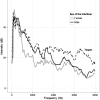Spatial release from masking in children with bilateral cochlear implants and with normal hearing: Effect of target-interferer similarity
- PMID: 26233032
- PMCID: PMC4506300
- DOI: 10.1121/1.4922777
Spatial release from masking in children with bilateral cochlear implants and with normal hearing: Effect of target-interferer similarity
Abstract
In complex auditory environments, it is often difficult to separate a target talker from interfering speech. For normal hearing (NH) adult listeners, similarity between the target and interfering speech leads to increased difficulty in separating them; that is, informational masking occurs due to confusability of the target and interferers. This study investigated performance of children with bilateral cochlear implants (BiCIs) when target and interferers were either same-sex (male) talkers, or different-sex talkers (male target, female interferer). Comparisons between children with BiCIs and NH, when matched for age, were also conducted. Speech intelligibility was measured for target and interferers spatially co-located, or spatially separated with the interferers positioned symmetrically (+90° and -90°) or asymmetrically (both at +90°, right). Spatial release from masking (SRM) was computed as the difference between co-located and separated conditions. Within group BiCI comparisons revealed that in the co-located condition speech intelligibility was worse with the same-sex vs different-sex stimuli. There was also a trend for more SRM with the same-sex vs different-sex stimuli. When comparing BiCI to NH listeners, SRM was larger for the NH groups, suggesting that NH children are better able to make use of spatial cues to improve speech understanding in noise.
Figures





References
-
- Boersma, P. , and Weenink, D. (1996). “ PRAAT: A system for doing phonetics by computer [computer program],” Report of the Institute of Phonetic Sciences of the University of Amsterdam No. 132.
-
- Boothroyd, A. (1997). “ Auditory development of the hearing child,” Scand. Audiol. Suppl. 46, 9–16. - PubMed
Publication types
MeSH terms
Grants and funding
LinkOut - more resources
Full Text Sources
Other Literature Sources
Medical

